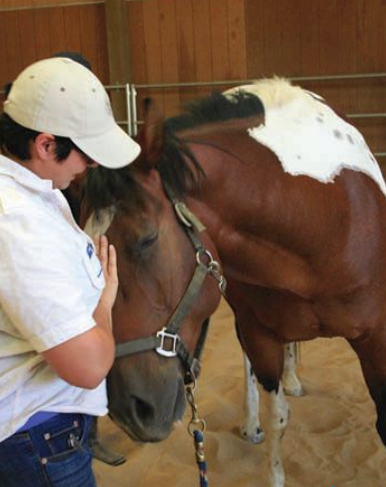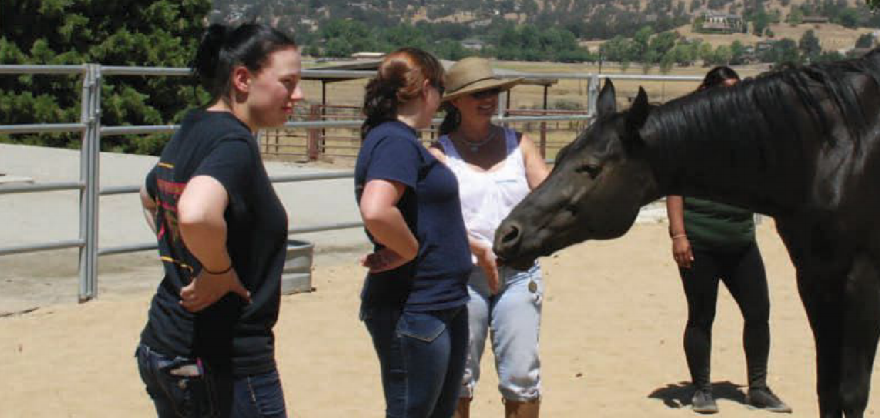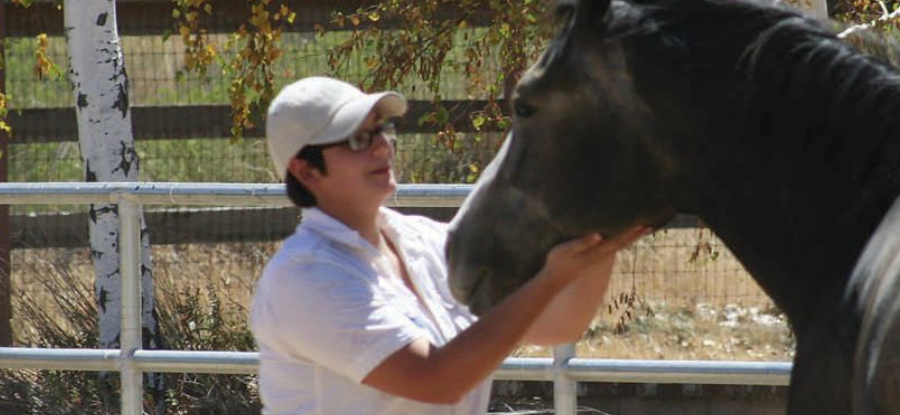Shared with permission from the Spring 2016 issue of PATH Intl. Strides.
Serving one’s country can be a double-edged sword. On one side, veterans can be extremely proud of the important role they play in safeguarding the nation. On the other side, serving in the military can leave veterans with physical, cognitive, emotional and/or developmental consequences that can result in long-lasting disabilities. Service-related disabilities affect both men and women service members. However, women veterans are disproportionately impacted by military sexual trauma (MST), sexual assault or sexual harassment, which can exacerbate existing disabilities, such as post-traumatic stress disorder (PTSD).
Healing Horses & Armed Forces (HHAAF), a PATH Intl. Premier Accredited Center in Tehachapi, CA,* which offers equine-assisted resilience programs for serving and returning military personnel, created the Women Warriors Training program to address the unique needs of women veterans. This program was the author’s response to viewing The Invisible Wounds of War, an in-depth documentary on the crisis of sexual assault in the U.S. military. The HHAAF program relies on the healing power of the horse to help participants process difficult experiences, reconnect with themselves, rekindle their sense of empowerment and self-efficacy and bond with other servicewomen to build a solid support network.
With any program focusing on women who have experienced sexual trauma, it is important to work with a licensed mental health specialist. Kathy Romans, a licensed mental health therapist who works at a domestic violence agency, directs a trauma treatment center and heads a sexual assault unit, works with HHAAF on its programing. The center’s founder Charisse Rudolph, a licensed resilience trainer, mentor and coach from the HeartMath Institute, provides equine-assisted resilience coaching.
“Because HHAAF works with groups that are part of existing programs at their base, for instance, at Fort Irwin, the women involved were in a program that was dealing with MST and the mental health specialists from the base were part of HHAAF’s programs as well,” said Rudolph. “I always have a licensed mental health specialist when dealing with PTSD or MST. HHAAF facilitates the program and then the participants go back to the base and continue this work with their mental health specialists.”
WOMEN IN THE MILITARY
The U.S. Department of Veterans Affairs estimates that 41% of women and 4% of men experience sexual harassment during their tour of duty, and one in five women is sexually assaulted or raped. According to an article in the Los Angeles Times, Amy Turk of Downtown Women’s Center suspects the numbers are even higher. “Sexual PTSD [an older term for MST] is a common thread, but most of the women aren’t comfortable sharing that,” she said. Another study by one of the bases HHAAF works with shared a review of 21 studies on MST. This review found rates of harassment from 55 to 70% and rates of sexual assault from 11 to 48%.

Women who experience MST usually respond differently to trauma than men, and the trauma can exacerbate other problems. For instance, almost 4,500 of the nation’s 58,000 homeless vets are female. Half of those women said they had been sexually victimized while serving their country.
Approximately 82% of all survivors say they were never the same again after being sexually assaulted. Approximately two-thirds of male and not quite half of all female survivors of MST suffer from PTSD, which is four times the rate brought on by combat-related trauma. Certain PTSD symptoms seem to be more common in women than men survivors, according to the National Center for Post-Traumatic Stress Disorder. Women are more likely to be jittery, anxious and depressed while men are more prone to be angry and abuse alcohol and drugs. In addition, survivors had three times the rate of depression and twice the rate of substance abuse. They experienced an increased risk of homelessness and suicide, more obesity, smoking and myocardial infarctions and increased rates of hysterectomies before the age of 40.
HHAAF’S INVOLVEMENT
Shortly after HHAAF started, a lieutenant from a nearby military base came to a demonstration day. She talked about the possibility of helping those at her base who were dealing with MST. The base’s figures were alarmingly high, averaging three reported sexual assaults a month. The Department of Defense (DOD) estimates that 13.5% of all sexual assaults are reported, which would indicate 22 actual assaults per month or 267 per year at her base.
Sexual assault is considered to be one of the most severe and psychologically damaging traumas. If unresolved, the trauma can severely degrade an individual’s ability to self-protect, leaving the victim more vulnerable to further abuse. Women service members often experience a heightened sense of powerlessness since their abuser may be someone who outranks them. Often, the abuse occurs in a heavily male-dominated environment that supports the perpetrator and denies or even denigrates the woman’s experience. Veterans in HHAAF’s Women Warriors Training program, for instance, have been Blackhawk helicopter pilots. One member was a mechanic who was married and living on base when she was assaulted. She then had to continue working with the perpetrator while the military carried out its investigation and procedures. Another veteran was one of only six women working aboard a submarine.

Some of the simplest and yet most profound activities involve facilitating women veterans to be in the moment. Staying present to herself and to her surroundings is difficult for a woman who has been traumatized, who has a sense of chronic instability and who has lost trust in herself and everyone else. A woman living in fear cannot easily connect with her needs and deeper desires to make good decisions. To help women make this connection, one of the equine-assisted activities in the program involves taking participants into the pasture to be in the moment, to become aware of their surroundings using all their senses.
The Women Warriors Training retreats range from one-day to multi-day events. HHAAF helps women warriors find greater inner freedom—freedom from fear of the future, release from guilt of the past and the courage to live in the present. Each activity builds on the next. Each step a woman takes empowers her to become more resilient. Through these activities, women are asked to look at how they can turn their trauma into personal power, how they can shift from being a victim and a survivor to being a warrior. In groups, they are asked to reflect on their energy, intention and how they communicate both verbally, emotionally and physically. The horses show the women warriors, who were willing to stand up for their country, what they need to do to stand up for themselves by taking back control of their lives and destiny.
JOURNEY OF SELF-DISCOVERY
To offer a program for women veterans when one of the main issues is MST, the facilitator must think about the group’s needs—for instance, increasing self-awareness, self-advocacy and a sense of empowerment—and then design a program with equine-assisted activities that will encourage this self-discovery. The beauty of incorporating equine partners is how they read the women’s energy and intention and mirror it back without judgment. Because the women do not feel threatened, they naturally open up and express their feelings. In addition, the women stop thinking about their past and their fears. The horses help them begin to trust their intuition, focus on the present and feel whole again. With an experienced facilitator and equine-assisted coach, the women warriors see life through the horse’s eyes and find their voice.
Here is a beautiful example of an equine activity that occurred in a one-day retreat for a group of 10- 12 women veterans. The morning began in the usual way with an initial icebreaker followed by a series of awareness exercises in the pasture and arena. After breaking for lunch, the women were asked to build a bridge to the future. They had prepared for this activity in the morning by taking small steps toward being present, so they could think about their future in the afternoon in the arena. Within the arena, which is also referred to as the community, was a wagon full of props. The group was told: “Build a bridge to your future, and think about what you want and what obstacles could get in your way. Let the props represent those obstacles by placing them on the bridge. Next, look through a selection of 40 or so attributes written on laminated cards, and choose the ones you will need to get past the obstacles. Tie the needed attributes onto the horse’s mane with string. Then, without touching or bribing the horse, have him walk over the bridge to your new future.”

The women divided themselves into two groups of five to six women. The older veterans took a few round poles and laid them on the ground to form a bridge. When they noticed one of the horses, whom they named Eight Ball, playing with some of the ball props, they placed the balls as the obstacles. Using their energy and working together, they managed to communicate their needs to Eight Ball, and he gladly walked back and forth several times.
The younger women built a bridge with poles going west/east and north/south and then used ropes to tie it together. The obstacles— play army men, a machine gun, a grenade, an alarm clock and snakes—embodied lots of negative energy. Their horse, whom they named Base, wouldn’t go anywhere near their creation. One of the women even sat in the center of the bridge with the energy of surrender. Base still refused to join them. Then, one of the participants gently put a hula-hoop around a willing Base to try to get him to move. He still wouldn’t budge. The facilitators found it interesting that he nudged her breast and when he did, she said, “Hey, that’s my breast, don’t do that.” However, Base would not take a step onto that side of the arena where the young women veterans had built their bridge.
In processing the activity with the facilitators, members talked about why each team had built the bridge in that particular manner and what the obstacles represented. Then everyone discussed what attributes they could call upon when an obstacle similar to the ones chosen came into their life. The energy and intention that each team was communicating was compared, and the women talked about the horses’ different reactions.
Finally they were asked, “Why do you think the two experiences were so different?” As the younger women listened to the older women’s comments and thoughts about the activity, they began to see how people’s thoughts might create energy. They began to see how the horses’ responses were a reaction to this sometimes-unconscious energy.
It has been said that horses are 1,000-pound lie detectors and able to read a person’s mind. In reality, they are probably not reading minds, but rather, as Base was doing, reading the participants’ heart rhythms, sensing their energy and responding to their body language. Horses help us grow more in tune with our own intuition, which bypasses language, and speaks directly to intent and the energetic manifestation of that intent in the moment. Because horses are honest about what they are sensing in their reactions to humans, this allows people to see themselves through the safety of horses’ non-judgmental eyes. As the HHAAF participants learn to be more self-aware and stay present to that awareness, they become more sensitive to the truths the horses are trying to communicate through their responses. The women can then transfer what they have learned to the wider circle of experiences and relationships in their lives.
*As of this republishing, Healing Horses & Armed Forces is no longer in operation.

Charisse Rudolph has been an experiential-based coach since 1992, working with Fortune 500 companies such as Disney, Hewlett Packard, Wells Fargo and 20th Century Fox. The winner of The Leadership Award for Contribution to Women, she is an Institute of HeartMath Mentor, Coach and Licensed Resilience Trainer. She is the author of The Art of Facilitation with 28 Equine Assisted Activities and is available to travel to facilities to give “train the trainer” workshops. She can be reached at risingmoonranch@gmail.com.


